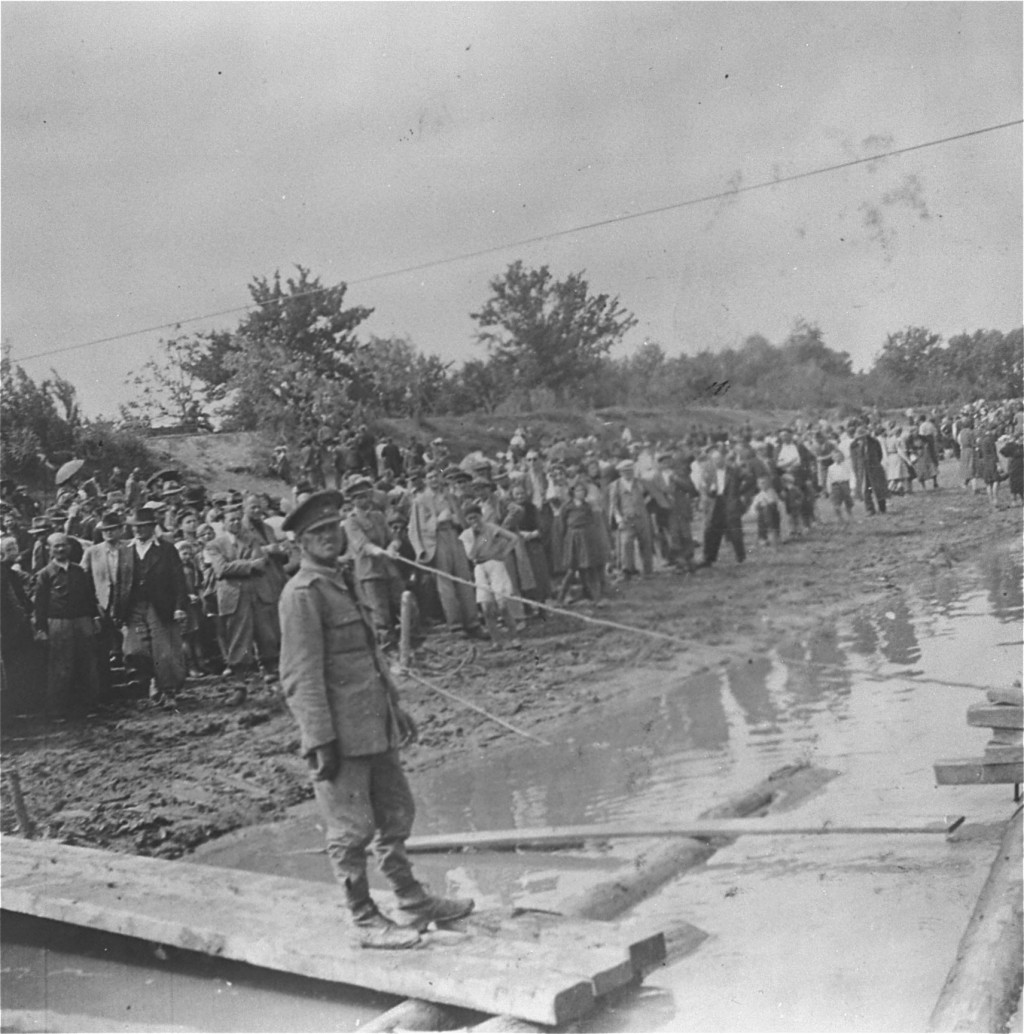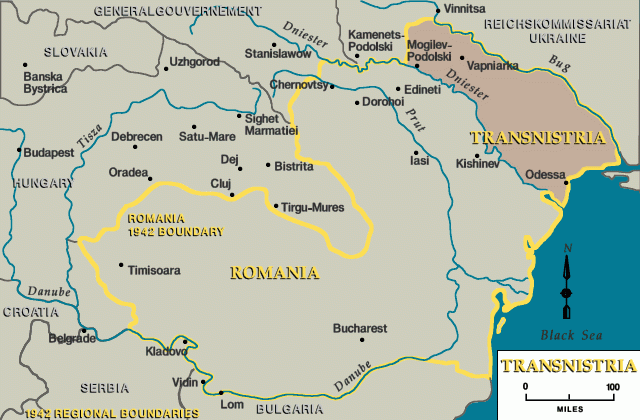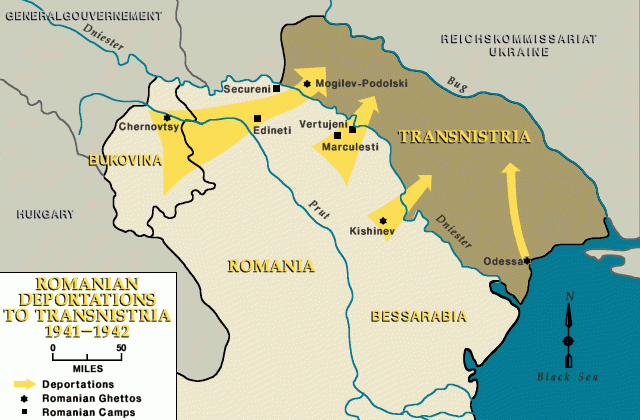
Transnistria Governorate
The Transnistria Governorate is also known as Transnistria. It was a Romanian administrative unit that governed part of occupied Soviet Ukraine. It lasted for nearly three years, between summer 1941 and spring 1944, during World War II. Transnistria was a key site of mass murder during the Holocaust.
Key Facts
-
1
The Transnistria Governorate existed between 1941 and 1944. Before the Axis powers invaded the Soviet Union, this area was part of Soviet Ukraine. Today, it is divided between southwestern Ukraine and Moldova.
-
2
During the Transnistria Governorate, Romanian authorities and local auxiliaries murdered an estimated 280,000 to 380,000 Jews. They killed Jews through neglect, in mass shootings, or through other mass violence.
-
3
The Romanian government deported an estimated 25,000 Roma (pejoratively called “Gypsies”) to Transnistria. At least 11,000 of them died of deprivation and maltreatment or were murdered.
The Transnistria Governorate is often referred to as Transnistria. It was a key site of mass murder during the Holocaust. The predominant perpetrators of the Holocaust in Transnistria were Romanians. German units and auxiliaries recruited from the area also carried out crimes against Jews in Transnistria. The auxiliaries included ethnic Ukrainians, Romanians, and Germans who lived in the region before the Axis invasion.
Shortly after taking control of the territory, Romanian authorities introduced harsh anti-Jewish policies. They also carried out massacres of Jews. The authorities deported to Transnistria tens of thousands of Jews from the regions of Bessarabia and Northern Bukovina. The deported Jews had to live in overcrowded ghettos alongside the local Jewish population. The Romanians also deported Roma from Romania to Transnistria. Thousands of Roma died from the lethal conditions they encountered there.
What was the Transnistria Governorate?
The Transnistria Governorate was a Romanian administrative unit. It governed part of Soviet Ukraine during the Axis occupation of the Soviet Union. Romania occupied Transnistria between 1941 and 1944. Odesa was the capital. It was the only major zone in the occupied Soviet Union that was administered by an ally of Nazi Germany; the rest was under direct German control.
Transnistria covered more than 16,200 square miles (about 42,000 square kilometers) between the Dniester and Southern Buh rivers. The territory stretched over 200 miles (about 345 kilometers) northwest from Odesa to the city of Zhmerynka. It was bordered on the east by the Southern Buh River, in the west by the Dniester River, and in the south by the Black Sea. In Romanian, “Transnistria” is a geographic designation that means “beyond the Dniester River.”
Prior to the Romanian occupation, this area was in the Ukrainian Soviet Socialist Republic, one of the Soviet Union’s national republics. Various censuses calculate the population at between 2.3 and 3 million people. The majority of these people were ethnic Ukrainians, but ethnic Romanians, Russians, Germans, and others also lived there. In addition, approximately 331,000 Jews resided in the area. More than half of them lived in Odesa.
Today, southwestern Ukraine and Moldova divide up the territory that was once the Transnistria Governorate.

Romania as Nazi Ally and Holocaust Perpetrator
In 1940, Romania became an ally of Nazi Germany. Then, in 1941, Romania joined in the Nazi-led invasion of the Soviet Union.
The roots of Romania’s role in World War II and the Holocaust dated to the late 1930s. At that time, antisemitism played an increasingly important role in Romanian society and politics. Also in this period, Romania became a dictatorship with growing ties to Nazi Germany.
Antisemitism in Romania in the 1930s
Prejudice against Jews was common in Romanian society in the nineteenth and twentieth centuries. In the 1930s, Romanian political leaders passed laws related to the economy and citizenship that in practice discriminated against Jews and negatively affected them. Political discourse often included anti-Jewish rhetoric. In December 1937, an explicitly antisemitic government came to power. Within weeks, the new government enacted a decree that would strip 225,222 Jews of their Romanian citizenship. This government was short-lived, but subsequent ones continued to embrace policies that targeted the country’s Jews.
Romania’s Geopolitical Situation, September 1939–Summer 1940
Competing priorities influenced Romania’s geopolitical situation at the start of World War II. On the one hand, Romania had long-standing diplomatic ties to Britain and France. On the other hand, Romania had a growing economic relationship with Nazi Germany. In particular, Nazi Germany was dependent on Romanian oil supplies. Due to these concerns, Romania declared a policy of neutrality in September 1939 when Germany invaded Poland and sparked World War II.
The Nazis redrew the map of Europe. They laid claim to their neighbors’ territories and rewarded their allies. Romania lost several regions in mid-1940 because of these land grabs. In June, the Soviet Union demanded that Romania cede the regions of Bessarabia and Northern Bukovina. Then in August, Germany and Italy forced Romania to surrender northern Transylvania to Hungary. The loss of these territories triggered a political crisis in Romania.
The loss of Bessarabia and Bukovina also gave rise to an antisemitic myth, which built on the older anti-Jewish concept of Judeo-Bolshevism. According to this new myth, Jews in Bessarabia and Bukovina were communists and traitors who had betrayed Romania in the summer of 1940. The Jews had allegedly welcomed the Soviet occupation forces and had looted or attacked the departing Romanian military. Indeed, some locals of various religions and ethnicities had done so. The Romanian military, however, blamed only Jews for this supposedly disloyal behavior.
Romania as Dictatorship under Antonescu
The territorial losses and resulting political crisis in mid-1940 led to the rise of Romanian dictator Ion Antonescu. Antonescu first came to power in September 1940. He was part of a coalition with the antisemitic Romanian fascist movement (informally called the Iron Guard). Just a few months later, the Iron Guard attempted a failed coup. Antonescu instead seized sole power, with the support of both internal and foreign allies. He ruled Romania as a military dictator from January 1941 until August 1944.
Romania Joins the Axis Powers, November 1940
Under Ion Antonescu, a primary foreign policy goal was to regain territory that Romania had lost before he rose to power. In hopes of achieving this goal, among others, Romania allied with Nazi Germany. On November 23, 1940, Romania became a member of the Axis powers.
As part of this alliance, Germany agreed to Antonescu’s claims over Bessarabia and Bukovina. Germany did not, however, support Romania’s claim to northern Transylvania. That region remained under the rule of Hungary, an Axis ally.

The Romanian Invasion of Soviet Ukraine and the Establishment of the Transnistria Governorate
In June 1941, Nazi Germany and its Axis allies, including Romania, attacked the Soviet Union. In July, German and Romanian troops invaded the Soviet-occupied regions of Bukovina and Bessarabia. These regions were quickly re-incorporated into Romania. Much violence against Jews occurred during the invasion. Romanian soldiers attacked and massacred Jewish communities. They were seeking revenge for the supposed betrayal by Jews a year earlier.
Romanian forces did not stop after invading Bessarabia and Northern Bukovina. They continued past the Dniester River, which was the 1939 Romanian-Soviet border. The first Romanian units crossed the river in mid-July. They moved deeper into Soviet Ukraine alongside their German allies. This more fully committed Romania to the war against the Soviet Union.
By mid-August 1941, Romanian and German troops controlled most of the territory that would soon be designated as the Transnistria Governorate. A notable exception was the city of Odesa, which remained under Soviet control until October 1941. In the wake of the invasion, German SS and police units carried out massacres of local Jews.
Creating the Transnistria Governorate
The Germans and Romanians negotiated what to do with the occupied territory between the Dniester and Southern Buh rivers. At Antonescu’s request, Hitler agreed to create a Romanian occupation zone. A German-Romanian agreement, known as the Tighina Agreement, formalized this arrangement. It delineated German and Romanian responsibilities and privileges in the region. This agreement came into effect on August 30, 1941.
Romanian Plans for Transnistria
Romanian dictator Ion Antonescu and other Romanian leaders did not have a clear long-term plan for Transnistria. They also did not agree on the best course of action. In the end, Antonescu chose not to annex Transnistria to Romania. The Romanians hoped that in the future they could use Transnistria as a bargaining chip to get back northern Transylvania. Romania had been forced to cede Transylvania to Hungary in August 1940.
The Administration of Transnistria
The Tighina Agreement called for a Romanian civilian authority based in Odesa to govern Transnistria. Antonescu appointed a Romanian law professor, Gheorghe Alexianu, to serve as governor. Alexianu wielded enormous power. Transnistria retained a separate status during the Romanian occupation. Romanian law did not apply there, and Governor Alexianu did not have to report to the central Romanian government. Some 6,000 Romanian gendarmes were responsible for security in the Transnistria Governorate. A large number of Romanian troops were also stationed in the territory.
Romanian Antisemitic Policies in Transnistria
Following the Axis attack on the Soviet Union in June 1941, the Romanian government escalated its actions against Jews. These actions affected all Romanian Jews, but to varying degrees. Some Jews faced discriminatory policies. Others were subjected to deportation and mass murder. The different experiences depended on a number of factors, especially where Jews lived in Romania.
Transnistria became a central location of mass murder of Jews by Romanians during the Holocaust. As part of Romania’s larger campaign of ethnic cleansing, Romanian authorities deported to Transnistria as many as 200,000 Jews from other parts of the country. Among those deported there were Jews living in Bukovina and Bessarabia.

Romanian authorities in Transnistria quickly, and somewhat chaotically, adopted measures to persecute Jews. For example, they required Jews to wear a Star of David badge on their clothing. Romanian authorities also looted Jews’ personal belongings and stole their valuables. In addition, they forcibly relocated and displaced Jews within Transnistria.
Romanian anti-Jewish policies in Transnistria affected both Jews who had lived in the territory prior to the occupation and those who had been deported there. In Transnistria, Romanian authorities forced Jews into about 150 improvised ghettos and camps, where they lived in overcrowded and unsanitary conditions. Sometimes, Jews were forced to live in run-down collective farms (called kolhospy or radhospy in Ukrainian). At other times, displaced Jews were sent to villages and not allowed to leave. There, they lived in dire conditions. In some cases, Jews occupied houses that had been abandoned or whose owners had been displaced or massacred. In other cases, displaced Jews lived alongside local Jewish communities. Community members shared their limited resources and even their homes. In most cases, Jews in Romanian camps and ghettos were required to perform forced labor.
Tens of thousands of Jews in Transnistria died from maltreatment, hunger, cold, or disease. The Romanian authorities did not provide Jews with sufficient food or water. These conditions left Jews vulnerable to epidemics that broke out in nearly every camp and ghetto. Romanian authorities deliberately allowed these epidemics to run rampant. They intervened only when there was a threat that disease might spread beyond the camps and ghettos. Romanian officials and local auxiliaries terrorized Jews through random acts of violence, including beatings, rapes, and shootings.
Romanians also carried out mass shootings in Transnistria. In particular, they murdered tens of thousands of Jews in and around Odesa and in the Bogdanovca camp. Other locations of mass shootings were mostly in the southern part of Transnistria.
During the Holocaust in Transnistria, an estimated 280,000 to 380,000 Jews were murdered. They were killed on the way to or in mass shootings and other forms of mass violence, or through inhuman conditions.

Deportations of Roma from Romania to Transnistria
The Romanian government also deported certain segments of the country’s Romani population to Transnistria.
In early twentieth-century Romanian society, Roma (pejoratively called “Gypsies”) faced discrimination due to stereotypes about their way of life. Under Antonescu, the Romanian government turned anti-Roma prejudices into state policy. The regime deported to Transnistria Romani people whom the authorities identified as nomadic, as chronically unemployed, or as having criminal histories.
Romanian authorities deported some 25,000 Roma to Transnistria between June and September 1942. At first, Romanian authorities forced the deported Roma to live in primitive conditions in or near villages in eastern Transnistria. The Roma could move around within designated areas (variously referred to in official documents as camps [lagăre] or ghettos). They were not allowed to leave, however.
In December 1942, Governor Alexianu issued a decree intended to regulate the detention of Roma in Transnistria, and their forced labor requirements. But, because the Romanian administration remained unorganized, labor assignments were scarce or never materialized. This meant that the Roma could not earn wages to meet even basic needs. When epidemics broke out, the Romani people suffered without access to medical care. Thousands of the deportees died from disease, starvation, or the cold during the winter of 1942–1943. The situation improved after the spring of 1943, although living conditions varied greatly from place to place.
Romani deportees never faced mass shootings by Romanians in Transnistria. An unknown number of Roma were murdered in isolated acts of violence, however.
Ultimately, Antonescu’s regime deported an estimated 25,000 Roma from Romania to Transnistria. At least 11,000 of these deportees died of maltreatment or were murdered.
Romania Scales Back its Anti-Jewish Policies in Transnistria
Romanian policy towards Jews became less radical as the war progressed. This was in large part related to the military situation. As a German victory seemed increasingly less likely, Romanian leaders sought to distance themselves from their Nazi ally.
After the spring of 1942, Romanian authorities ceased their large-scale mass shootings in Transnistria. Smaller-scale killings continued, however. In October 1942, Antonescu’s regime stopped deporting Jews from Bessarabia and Bukovina to Transnistria. Tens of thousands of Jews in Transnistria had already died by this time, and thousands of others continued to die of maltreatment.
Jewish community leaders in Romania pressured Antonescu’s regime to send back Romanian Jews who had been deported to Transnistria. In December 1943, as the military front moved closer, Antonescu’s government conceded. It began allowing some of the deported Jews to return. These efforts continued until the Red Army drove out the Romanians in the spring of 1944. At that point, Antonescu permitted the return of all surviving Romanian Jewish deportees.
Romanian authorities did not organize the return of Roma who had been deported to Transnistria. Nevertheless, many of them went back to Romania as the Romanian military retreated.
The End of the Romanian Occupation
As the Red Army approached, the Romanians started planning their withdrawal from Transnistria. On February 15, 1944, the Romanians abolished the governorate and put a military administration in its place. For a short time in March 1944, they placed the territory under the control of German authorities, who were in turn pushed out by the Soviets.
Footnotes
-
Footnote reference1.
This article refers to the historical territory that existed between 1941 and 1944. It is not connected to or coextensive with the present-day unrecognized state, the Pridnestrovian Moldavian Republic, which is commonly known as Transnistria in English. The present-day state includes a fraction of the territory of the former Transnistria Governorate.
-
Footnote reference2.
Bogdanovca was the Romanian name for the Ukrainian village of Bohdanivka, located along the Southern Buh River.

